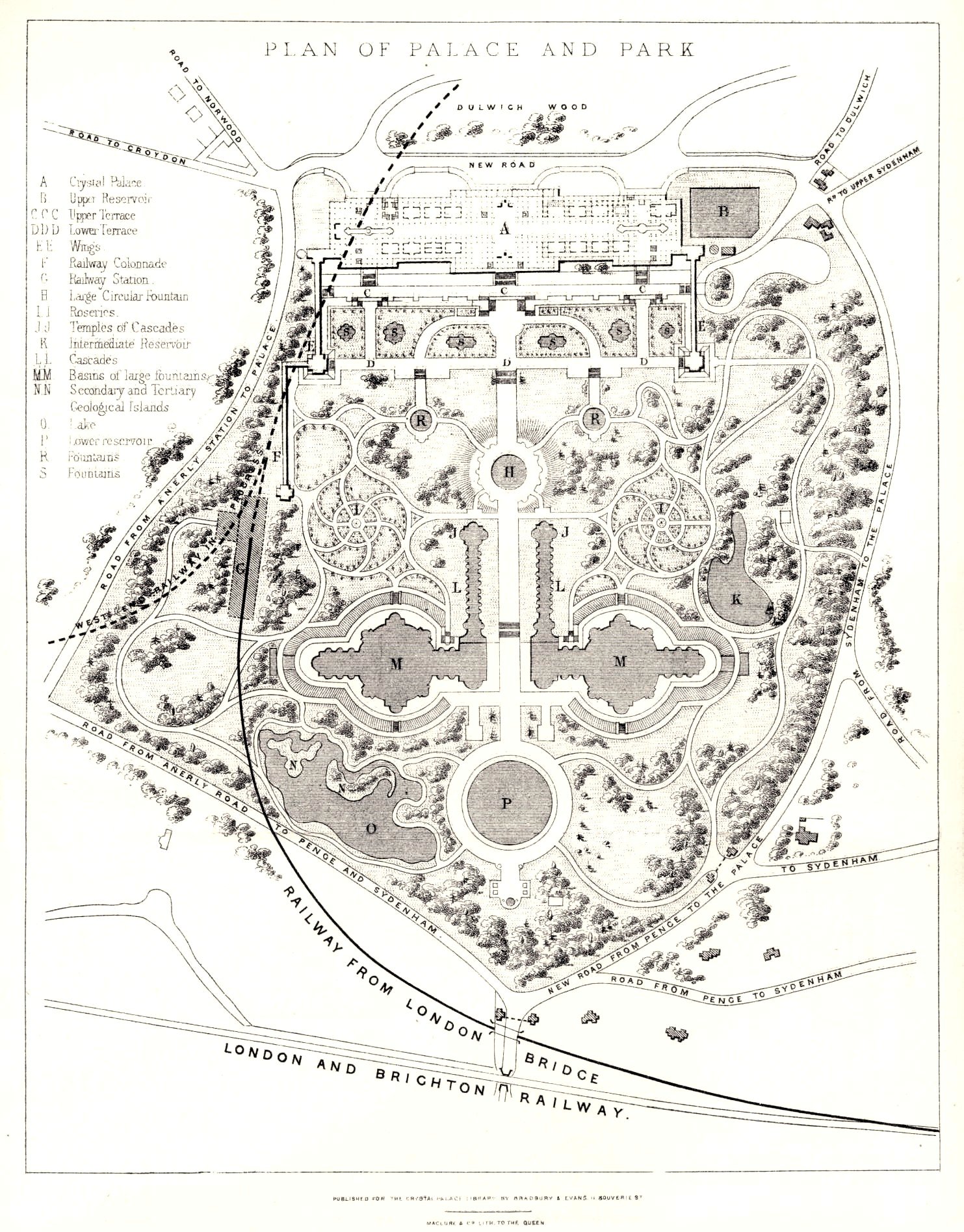Crystal Palace Park
- London ~MDCCCLXXXVIII~ Caer Ludein ~MCM~ London - Pax Britannica
Contents
Intro
Crystal Palace Park is a Victorian pleasure ground, used for cultural and sporting events. It is located in the south-east London suburb of Crystal Palace, which was in turn named after the Crystal Palace Exhibition building, which had been moved from Hyde Park, London after the 1851 Great Exhibition and rebuilt with some modifications and enlargements to form the centrepiece of the pleasure ground, before being destroyed by fire in 1936. The park features full-scale models of dinosaurs in a landscape, a maze, lakes, and a concert bowl.
This site contains the National Sports Centre, previously a football stadium that hosted the FA Cup Final from 1895 to 1914 as well as Crystal Palace F.C.'s matches from their formation in 1905 until the club was forced to relocate during the First World War. The London County Cricket Club also played matches at Crystal Palace Park Cricket Ground from 1900 to 1908, when they folded, and the cricket ground staged a number of other first-class cricket matches and had first been used by Kent County Cricket Club as a first-class venue in 1864.
The park is situated halfway along the Norwood Ridge at one of its highest points. This ridge offers views northward to central London, eastward to the Queen Elizabeth II Bridge and Greenwich, and southward to Croydon and the North Downs. The park remains a major London public park. The park was maintained by the LCC and later the GLC, but with the abolition of the GLC in 1986, control of the park was given to the London Borough of Bromley, so the park is now entirely within the London Borough of Bromley.
The park is Grade II* listed on the Register of Historic Parks and Gardens.
History
After the 1851 Great Exhibition in Hyde Park, Joseph Paxton appealed for the retention of The Crystal Palace in Hyde Park, but the government decreed that the Palace be removed. Paxton formed the Crystal Palace Company to purchase the Hyde Park Crystal Palace for £70,000, as well as a new site at the summit of Sydenham Hill in Kent for the construction of an enlarged Crystal Palace which cost a total of £1.3 million. The 389-acre site consisted of woodland and the grounds of the mansion known as Penge Place owned by Paxton's friend and railway entrepreneur Leo Schuster. This land as enclosed in the early 19th century previously made up the northern part of Penge Common, a large area of wood pasture which abutted the Great North Wood. Between 1852 and 1854, an enlarged and redesigned Crystal Palace was rebuilt at the new site, set in a park constructed by Sir Joseph Paxton's Crystal Palace Company.
The development of ground and gardens of the park (which straddled the border between Surrey and Kent) cost considerably more than the rebuilt Crystal Palace. Edward Milner designed the Italian Garden and fountains, the Great Maze, and the English Landscape Garden, and Raffaele Monti was hired to design and build much of the external statuary around the fountain basins, and the urns, tazzas and vases. The series of fountains constructed required the building of two 284 ft (87 m) high water towers, designed by Isambard Kingdom Brunel, at either end of the palace. The sculptor Benjamin Waterhouse Hawkins was commissioned to make 33 lifesized models, completed in 1854, of the (then) newly discovered dinosaurs and other extinct animals in the park. The park was also given a gift of a megatherium skull by Charles Darwin. The rebuilt Crystal Palace was opened by Queen Victoria in June 1854.
Rail access to the park became possible when the Crystal Palace railway station opened in 1854. In 1864, Thomas Webster Rammell experimented with a 600-yard pneumatic railway in the tunnel between the Sydenham and Penge gates to the park.[10] In 1865, another station, the Crystal Palace (High Level) railway station opened, but this station closed in 1954.
The park has been used for various sporting activities from its early days. The Crystal Palace Park Cricket Ground was created on the site in 1857. In 1894, the two largest fountains were grassed over and the south basin was converted to a football stadium in 1895. The stadium was used to host FA Cup Finals for 20 years starting with the 1895 FA Cup Final until 1914. Crystal Palace F.C. also played their home games at the stadium from 1905 to 1915.
In 1911, the Festival of Empire was held at the park and the park was transformed with buildings designed to represent the British Empire. Many of these buildings remained at the site until the 1940s.
In 1936, The Crystal Palace burnt down. The south water tower was demolished soon afterwards due to fire damage. The north water tower was demolished in 1941, perhaps to eliminate landmarks that German bombers might use to orient themselves during air raids in the Second World War.
A 400 ft-long Marine Aquarium was built in 1872 on a part of The Crystal Palace site left vacant after a fire in 1866, but it was not a financial success. A large section of it was destroyed during the demolition of the north water tower. The Crystal Palace transmitting station was built on part of the site of the aquarium in the 1950s.
The park also housed one of the pioneer speedway tracks, which opened for business in 1928. The Crystal Palace Glaziers raced in the Southern and National Leagues up to 1933 when the promotion moved on to a track in New Cross. The extensive grounds were used in pre-war days for motorcycle racing and, after the 1950s, for motorcar racing; this was known as the Crystal Palace circuit. Large sections of the track layout still remain as access roads around the park. The circuit itself fell into disuse after the final race in 1972, although it has been digitally recreated in the Grand Prix Legends racing simulation and 2010 sees the 10 years of campaigning work to reopen the track culminating in Motorsport at the Palace.
The National Sports Centre (NSC) was built in 1964 on the old football ground. In 2005 the Mayor of London and the London Development Agency (LDA) took control of the NSC as part of London's bid for the 2012 Summer Olympics and Paralympics, and it is now managed by Greenwich Leisure on their behalf. The park also once housed a ski slope.
After the abolition of the Greater London Council, the ownership of the park was transferred to London Borough of Bromley in 1986, which oversaw a number of restoration works on the site. A third of the park was restored between 2001 and 2003, including the dinosaur figures.
Sites of Interest
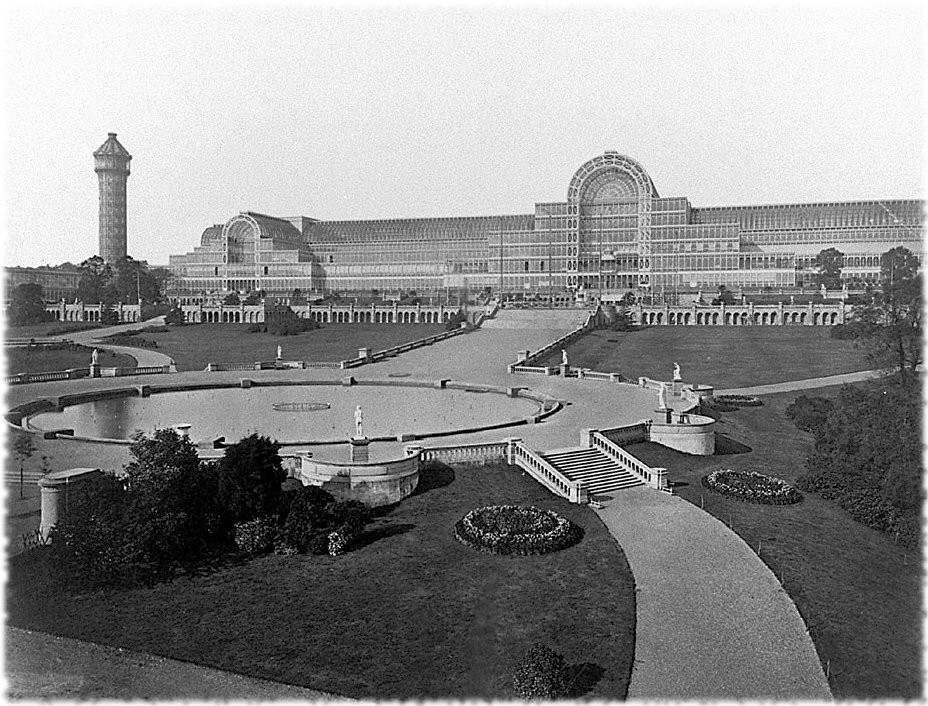
Bust of Sir Joseph Paxton -- The park contains a large bust of Sir Joseph Paxton, first unveiled in 1873. It was sculpted by William F. Woodington, and was originally located looking towards the Palace building over the central pool on the Grand Central Walk.
Crystal Palace Dinosaurs -- A group of sculptures of dinosaurs and extinct mammals complete with a 'geological' landscape, are in and around the 'tidal lake' at the southeast side of the park.
Crystal Palace (High Level) railway station -- was a station in what was the Metropolitan Borough of Camberwell in south London. It was one of two stations built to serve the site of the 1851 exhibition building, called the Crystal Palace, when it was moved from Hyde Park to Sydenham Hill after 1851.
Crystal Palace (Low Level) railway station -- The Low Level station is a pneumatic railway, or experimental atmospheric railway that ran in Crystal Palace Park in south London in 1864.
Italian Terraces & Sculptures -- The upper and lower terraces are linked by flights of steps with sphinxes flanking each flight.
Maze -- The maze is 160 ft in diameter and occupies a total area of nearly 2000 square yards. The maze was first created around 1870, and it was one of the largest mazes in the country.
The Crystal Palace -- was a cast-iron and plate-glass structure originally built in Hyde Park, London, to house the Great Exhibition of 1851. The exhibition took place from 1 May until 15 October 1851, and more than 14,000 exhibitors from around the world gathered in its 990,000 square feet (92,000 m2) exhibition space to display examples of technology developed in the Industrial Revolution. Designed by Joseph Paxton, the Great Exhibition building was 1,851 feet (564 m) long, with an interior height of 128 feet (39 m). It was three times the size of St Paul's Cathedral.
The introduction of the sheet glass method into Britain by Chance Brothers in 1832 made possible the production of large sheets of cheap but strong glass, and its use in the Crystal Palace created a structure with the greatest area of glass ever seen in a building. It astonished visitors with its clear walls and ceilings that did not require interior lights.
It has been suggested that the name of the building resulted from a piece penned by the playwright Douglas Jerrold, who in July 1850 wrote in the satirical magazine Punch about the forthcoming Great Exhibition, referring to a "palace of very crystal".
Venetian Fete -- In 1884 a ‘Venetian Fete’ was inaugurated, illuminating the English Garden Landscape to spectacular effect with a display of 15,000 oil lamps dotted around the grounds and 2,000 coloured Chinese Lanterns suspended from the trees. The small lake was decorated with a series of semi-circles, floating on the surface and gradually diminishing in size, their reflections in the water giving the appearance of rings of light stretching into the distance. The Venetian Fete illuminations were choreographed by the pyrotechnic specialists Brocks, well known for their firework displays at the Palace.
Avatar 1888 -- Overworld Park
The Crystal Palace Park in general and the Water Temple specifically serve as Touchstones that grant access to the terrae incognitae home of the new gods - Overworld Park. Overworld Park is an idealization of the Crystal Palace Park and all it contains. This terrae incognitae contains many strange and wondrous things that are absent from the mundane park.
While Overworld Park can only be reached from the grounds of the Crystal Palace Park, leaving from either of the two stations, high level or low level allow one to transition from the park to anywhere in London 1888. As above, so below. The High Level Station can transport passengers to any mundane location within London and the Low Level Station can transport passengers to any subterranean location in London as well as its version of the Underworld.
Overworld Park is defended by 33 mechanical (steam driven) dinosaur golems that graze the length and breadth of the grouds. These beings are semi-aware and have a limited tactical response that by no means moderates their capacity for violence.
Mortal favorites of the New Gods can be seen wandering the grounds, some are servants, while others are guests who have been brought here for inspiration.
New Gods
- ~
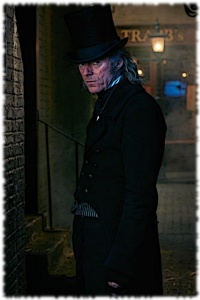 -- Zanziuer Gorsedd {ZAN-zur GORs-head} -- God-confessor of Propriety
-- Zanziuer Gorsedd {ZAN-zur GORs-head} -- God-confessor of Propriety - ~
 -- Vanix Korzinthio {Van-ix Core-zi-neo} -- Lady Goddess of Wisdom & Science
-- Vanix Korzinthio {Van-ix Core-zi-neo} -- Lady Goddess of Wisdom & Science - ~
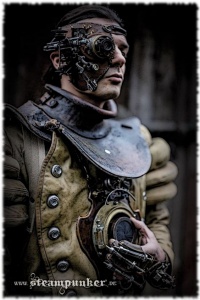 -- Jur Gadget {Ure-Gadget} -- Male God of Industry
-- Jur Gadget {Ure-Gadget} -- Male God of Industry - ~
 -- Peueriz Mammon {pure-eez MAmmon} -- God-father of Trade & Wealth
-- Peueriz Mammon {pure-eez MAmmon} -- God-father of Trade & Wealth - ~
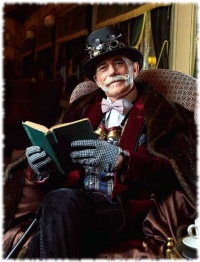 -- Crizanta Gallivant {chryzanta Gallee-vant} -- Lord God of Exploration
-- Crizanta Gallivant {chryzanta Gallee-vant} -- Lord God of Exploration - ~

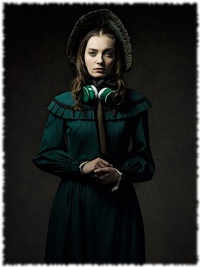
 -- Falschin Tatelen {fall-shin tate-lynn} -- Goddesses Triumvirate of Media
-- Falschin Tatelen {fall-shin tate-lynn} -- Goddesses Triumvirate of Media
- ~
Sources
https://en.wikipedia.org/wiki/Crystal_Palace_Park
https://en.wikipedia.org/wiki/The_Crystal_Palace
https://en.wikipedia.org/wiki/Crystal_Palace_(High_Level)_railway_station
https://en.wikipedia.org/wiki/Crystal_Palace_pneumatic_railway
